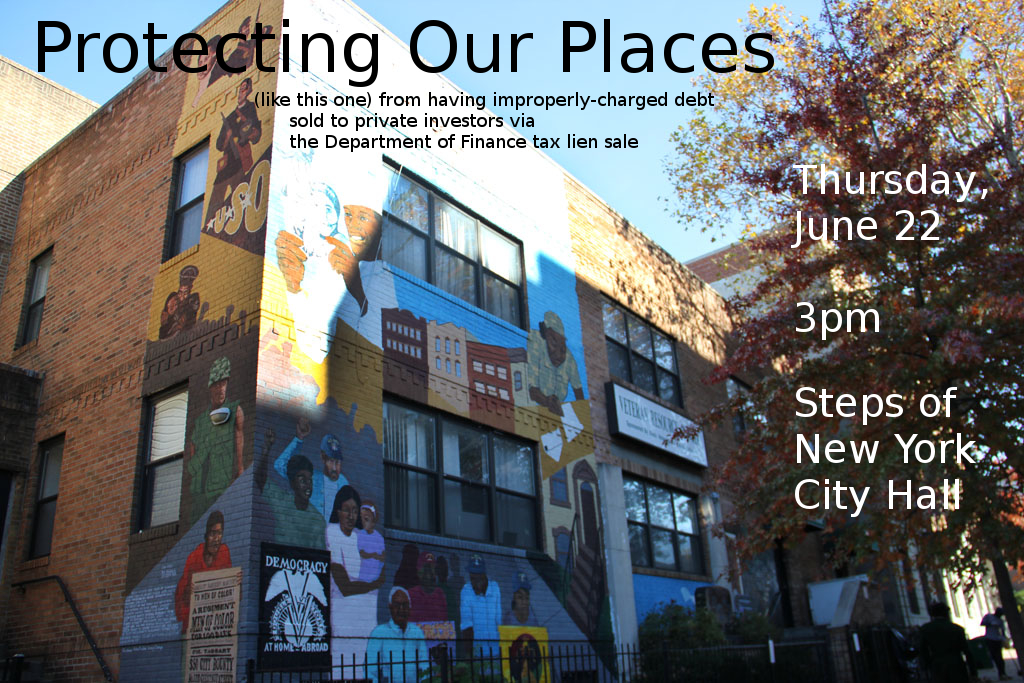Testimony to the Committee on Housing and Buildings, Vacant Property In NYC
Hello Chair Williams and members of the Committee. My name is Paula Segal and I am the Director of 596 Acres, New York City’s community land access advocacy organization. Thank you for opening up the conversation about vacant properties in New York City and giving me an opportunity to speak. I am going to focus my remarks on vacant land in New York City. I am glad to see that other advocates are here to address the opportunities presented by other types of vacant property.
I will divide my comments into and make recommendations for three distinct types of vacant land, as found in our neighborhoods: (1) vacant lots in the City portfolio, (2) privately-owned vacant lots, and (3) lots that will soon be acquired by the City in neighborhoods impacted by Superstorm Sandy.
City-Owned Vacant Lots
Across the five boroughs, there are approximately 540 acres of city owned vacant land. This land is divided among different agencies, with the bulk of it in the inventory of DCAS (510 lots, 185 acres), HPD (1025 lots, 181 acres) and SBS (42 lots, 80 acres). MTA has an at least additional 99 acres of vacant land in New York City; while not a city agency per se, their vacant land impacts New Yorkers in much the same way.
The primary area of work of 596 Acres is identifying opportunities for New Yorkers to shape their own neighborhoods; facilitating the transformation of city-owned vacant land into community spaces is a big part of this. In the last two years, twenty groups we have worked with in Brooklyn, Manhattan and Queens have gotten permission to change 5 acres of weeds behind fences into flower gardens, play spaces, vegetable bounties and other community resources. Some of these groups have direct agreements with city agencies that allow them to use the land and others are licensed through the GreenThumb program, either as temporary interim-use spaces that remain in the jurisdiction of other agencies or as groups managing lots that have been transferred to the Parks Department. We are working with approximately 120 other groups who are exploring the potential for transformation latent in 52 acres of vacant lots in their neighborhoods.
We have been able to find lots that are good candidates for such transformations because they are too small to build on without a variance under the modern building code — 100 Quincy Community Garden in Bed Stuy, formed last year, is one such lot which was formerly in Housing Preservation and Development’s inventory; St Nicholas Miracle Garden in Harlem, which was a school garden in the 1930s and then a sliver of the Department of Citywide Administrative Services portfolio for half a century before becoming a garden again last year, is another. These transformations are a testament to the fact that not all land in the city’s portfolio presents a future opportunity for housing development.
I urge this committee to require the agencies to examine their inventory and transfer lots that are not well-positioned for development to other agencies – such as the Parks Department – that can turn them into public benefits. Our analysis of the city’s property portfolio is based on datasets available through the open data portal and direct input from New Yorkers. I hope that our map, which you can see at 596acres.org, will be useful to this committee as it looks closely at the City’s vacant land portfolio.[1]
One strategy that we use is actually labeling public lots so that neighbors are the first to know that these spaces present an organizing opportunity for open space or other community-enriching development. We urge the City to adopt this successful tactic to make information about public land transparent and available through signage that announces that the land is publicly owned and suggests ways that neighbors can get access to it. These signs can announce programs like GreenThumb and the DOT Plaza program directly on the locations that could participate in these programs and directly to the people who already walk by those places.
On the other hand, some land in the city portfolio is extremely right for development. We urge the Committee to explore strategies for making sure that development on these sites is as strongly influenced by people who live and work near them as possible. One suggestion for how to enable greater public participation: require developers to put up signs on sites where development is proposed or where land use review is imminent in advance of public comments being accepted on the proposals. Signs should clearly indicate that input from local communities is invited and how it will be accepted.
Another suggestion is having the Council review all imminent development proposals for Community Benefit Agreement opportunities and make sure that, where such opportunities exist, already-organized groups like tenants’ associations, churches and block associations, are the first to know and get training about the legal mechanisms involved.
Privately-Owned Vacant Lots
There are over 2,400 acres of vacant privately-owned land in New York City.[2] These are sites that present opportunities for collaboration between the owners and neighbors. We support neighbors who reach out to us when they try to negotiate for access to these lots in their neighborhoods as well, with some success. I would ask you to help incentivize this collaboration and am pleased that the Council considered a resolution last year in support of state legislation that will permit the Department of Finance to create a new tax abatement program – modeled on the not-for-profit property tax abatement – for owners who let their lots’ neighbors use them to create temporary parks, farms and open spaces. This program will reward owners who work with their lots’ community and neighbors to convert an underutilized fenced off lot into a resource.[3] With such a reward, it will be easier for more private owners of the holes in our city to opt into cooperation with their neighbors.
It’s important to note that this tax inventive goes hand in hand with the Mayor’s proposed plan to tax vacant land to encourage development. Together, they shift the incentives away from private owners’ warehousing unused land in areas zoned for residential construction with no benefit to the public.
Acquisition for Redevelopment in the Wake of Superstorm Sandy
Land that will be acquired by the City of New York will become public land and presents opportunities for neighbors to control development in communities where Sandy made a lack of control the norm. I hope this committee will explore legislative options for creating conditions for equitable use of this public resource.
Following Sandy, the federal government set aside funds for the State and City of New York to acquire destroyed or damaged properties. Some funds will be used to buy homes for the creation of open space that will serve as a buffer against future storms. Other funds will be used for an acquisition program that earmarks lots for city redevelopment. This redevelopment program is still unwritten and I urge the members of this Committee to focus attention on it as a neighborhood redevelopment program early this year. New development in Sandy-affected areas should be mixed-income and reflect pre-Sandy income levels – not so-called “middle-income” levels that are well out of the means of neighborhood residents and actual middle-income New Yorkers. Preference should be given to displaced residents. Long-term affordability mechanisms should be put in place.
We have a unique opportunity to redevelop these areas in ways difficult to implement in other New York City neighborhoods. Block grant funding can be used to support new community land trusts and non-profit, neighborhood-based development corporations. These trusts and developers must be under a mandate to create and permanently maintain housing that is affordable to neighborhood residents who have been displaced by the disaster or by the unworkable economics of the storm recovery process.
With the opportunity to redevelop large swaths of land, the incoming administration has an incredible opportunity to stabilize New York City’s low- and moderate-income coastal neighborhoods. Site design and community engagement in the design process will shape New York City’s future social and ecological resiliency. It will determine whether the storm leaves in its wake safer communities for those who experienced it first hand or an opportunity for speculation and developer-driven change along our coastlines.
Thank you very much for accepting my testimony today.
[1] See http://livinglotsnyc.org/about/living-lots-nyc-data/ for a step-by-step description of how we have transformed the lines of spreadsheet data into information neighbors can use.
[2] These numbers are from Columbia Urban Design Lab’s report “The Potential for Urban Agriculture in New York City: Growing Capacity, Food Security, & Green Infrastructure,” available at http://urbandesignlab.columbia.edu/files/2015/04/4_urban_agriculture_nyc.pdf (2012). There’s a caveat here: the Lab’s numbers turned out to be about twice the amount of public vacant land in reality when we subjected the city’s data to a more refined process (see http://livinglotsnyc.org/about/living-lots-nyc-data/); we’d love to do the same for private lots but need some fiscal support to be able to do it. But even if we half the numbers above, that is an awful lot of acres. If we had support to refine the city’s data regarding private vacant lots, the process would look like this: (1) We would start with MapPLUTO, which is the most complete and up-to-date land use database for the city. (2) We would filter the data to find just the parcels with private owners that have no buildings on them. (3) Someone would then look at each parcel individually using satellite imagery and Google Streetview to ensure that the parcel is actually not in use.
[3] See The Sustainable Economies Law Center, Policies for a Shareable City #11: Urban Agriculture, available at http://www.shareable.net/blog/policies-for-a-shareable-city-11-urban-agriculture (2011). Here’s California’s version of a tax incentive bill, passed in 2013: http://leginfo.legislature.ca.gov/faces/billNavClient.xhtml?bill_id=201320140AB551(cities like Los Angeles and San Francisco are implementing this enabling legislation through ordinance now).






